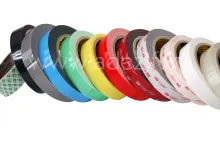Adhesive Velcro: overview of different adhesive masses
- Adhesive characteristics of Velcro
- How to choose the right adhesive for your Velcro
- All products by adhesive type
Quote
Close
You request has been sent.
We promise to respond to you in detail within 24 hours.
In the meantime, feel free to browse our other products.
Technical characteristics of adhesive masses on Velcro
Velcro strips consist of one side made up of soft loops called Velour or Astrakhan, and one side with hooks. The two assembled faces allow for a removable assembly that can either be sewn or glued to the final support.
For adhesive Velcro, each side can have identical or different adhesive masses, depending on the supports to which each side is adhered. For example, the velour side may be glued to a tarp while the hook side is glued to wood or metal. It is important to know the characteristics of each adhesive mass before choosing a type of Velcro, in order to optimize the final adhesion to the support.
The Velcro strip with glue can thus be likened to a double-sided adhesive tape with a protector!
Three main adhesive masses are distinguished:
Rubber: Either in resin or made from rubber copolymers. They are pressure-sensitive and provide good adhesiveness on low-energy surface supports. However, it is preferable to use them indoors at room temperature. The PS 15 glue has a specific formulation offering fire resistance according to the FAR 25853 standard.
Acrylic water-based: Also pressure-sensitive, they exhibit good shear resistance and are used on supports with plasticizer migration, such as PVC tarps and vinyls. Another advantage is their resistance to moisture and high temperatures.
Heat-activated or solvent-activated adhesives: Recommended for applications where a more durable and permanent adhesion is desired. They are dry to the touch and become sticky when activated using ultrasonic, high-frequency welding, ironing, or application of hot air or solvents.
Comparative table to help you choose Velcro
The table below allows you to compare the most common adhesive masses present on adhesive VELCRO: PS14, PS15, PS18, PS19, PS30, PS51, PC28.
| NAME OF ADHESIVE | TYPE | CHARACTERISTICS | TEMPERATURE RANGE |
|---|---|---|---|
| PS 14 | Rubber resin | Versatile, to be used on smooth supports such as glass, melamine wood, metal, cardboard, paper | -15°C to 90°C |
| PS 15 | Rubber copolymers | Fireproof and compliant with FAR 25853 standard for fire resistance | -15°C to 60°C |
| PS 18 | Water-based acrylic polymer | To be used on products containing plasticizers such as PVC tarps, vinyls. Good resistance to moisture and high temperatures. | -20°C to 120°C |
| PS 19 | Rubber copolymers | Very effective on all surfaces (except vinyl) and especially on polyolefins (PP and PE) | -30°C to 70°C |
| PS 30 | Rubber copolymers | Special for difficult-to-adhere surfaces such as polyethylene (PE) or polypropylene (PP) | -15°C to 60°C |
| PS 51 | Rubber resin | Similar to PS 14 but with double thickness, making it very effective on irregular or rough surfaces. High shear strength. | -15°C to 90°C |
| PC 28 | Nitrile with solvents (acetone, MEK) | Dry to the touch, the adhesive is reactivated by heat, ultrasound, or high frequencies. Adhesion occurs by fusion of materials. Usable on all supports, including PVC. | -15°C to 100°C |










